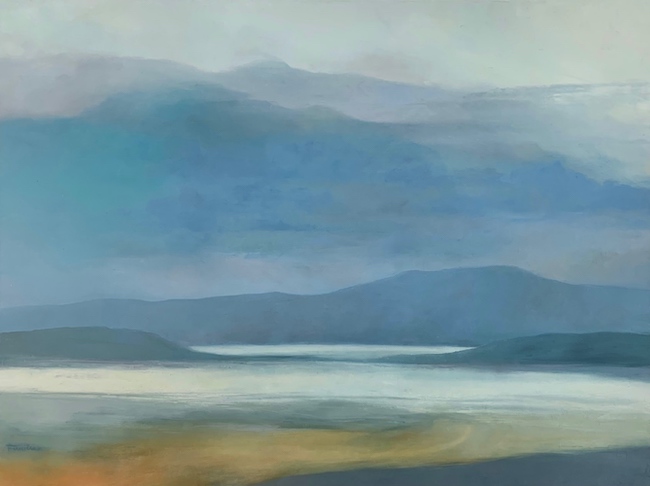L’arte contemporanea si pone spesso come superamento di tutto ciò che appartiene a un’epoca o un approccio più tradizionale, continuando quel distacco generato nel Ventesimo secolo che induce tutt’oggi molti creativi a cercare un linguaggio distintivo, unico, per segnare il proprio percorso espressivo e per dare un’impronta personale alle loro opere; esiste però anche un nutrito gruppo di artisti che al contrario cerca, si riallaccia e si lascia ispirare proprio da quel passato apparentemente lontano eppure incredibilmente efficace nel permettere loro di lasciar emergere le proprie sensazioni senza per questo sentir messa in discussione la loro contemporaneità, la loro modernità nel coniugare lo stile con la capacità di connettersi con il proprio mondo interiore e, di conseguenza, interpretativo dell’osservato. L’artista che vi presenterò oggi si lega a un filone artistico affascinante e coinvolgente, legandosi fortemente a uno stile del passato ma incredibilmente personalizzato.
La tendenza pittorica di immortalare scene all’aria aperta, evidenziando la natura o il contatto tra di essa e l’essere umano, venne considerata fino al Seicento come arte minore poiché le commissioni principali giungevano ai grandi pittori dalla Chiesa o da famiglie reali e nobili pertanto i soggetti erano quasi esclusivamente religiosi e storici; a partire dal Seicento invece, in particolar modo in Olanda, cominciò a affermarsi il paesaggio come genere principale affiancandosi ad altri soggetti che in precedenza non erano degni di nota. Fu però tra la fine del Settecento e l’inizio dell’Ottocento che questo genere ebbe i suoi massimi rappresentanti, perché già verso gli ultimi anni del Diciottesimo secolo il Romanticismo inglese trasformò la capacità di rappresentare le vedute marine o di campagna in espressioni dell’interiorità dell’artista, di quella narrazione di ciò che veniva definito sublime, inteso come timore e senso di impotenza nei confronti della forza e impetuosità della natura; due tra i massimi esponenti di questa corrente pittorica destinata a lasciare un profondo segno nella storia dell’arte e a essere preludio delle ricerche successive, furono William Turner e John Robert Cozens, che fecero del tema del sublime la loro maggiore espressione. I panorami tempestosi e irruenti di Turner e le atmosfere nebulose ed evocative di Cozens hanno la forza espressiva di coinvolgere l’osservatore e al tempo stesso trasmettergli l’interpretazione delle sensazioni che l’autore delle tele sentiva il bisogno di manifestare, lasciandolo a riflettere sulla maestosità indomabile della natura. Ciò che colpiva nelle opere di Turner era il rapporto con la luce, quella luminosità in grado di infondere alle atmosfere un aspetto impalpabile, rarefatto, quasi in contrasto con gli eventi descritti. Fu proprio la sua produzione artistica a gettare le basi per l’Impressionismo, che fece proprio del paesaggio una caratteristica distintiva anche per la particolarità di dipingere en plein air descrivendo con minuziosità la perfezione dei colori avvalendosi dell’effetto della luce e tralasciando il disegno proprio per infondere la sensazione di immediatezza e per assecondare l’esigenza di velocità esecutiva possibile grazie alla nuova tecnica pittorica costituita dal piccoli e brevi tocchi di colore accostati e mescolati tra loro per comporre l’opera finale. La tela Impression, soleil levant di Claude Monet è considerata l’opera che decretò ufficialmente la nascita dell’Impressionismo e che, pur inseguendo la perfezione estetica, infonde nell’osservatore un impulso contemplativo, più profondo di quello puramente estetico che invece costituiva la tendenza espressiva della corrente. L’artista canadese Nathalie Frèniere trae ispirazione dall’Impressionismo tuttavia non si può non notare la vicinanza con le atmosfere del Romanticismo inglese di William Turner, sebbene in lei più che la soggezione provocata dalla natura che permea le opere del maestro inglese emerga l’aspetto contemplativo, quello che conduce a un’introspezione attraverso lo sguardo coinvolto dai panorami descritti.
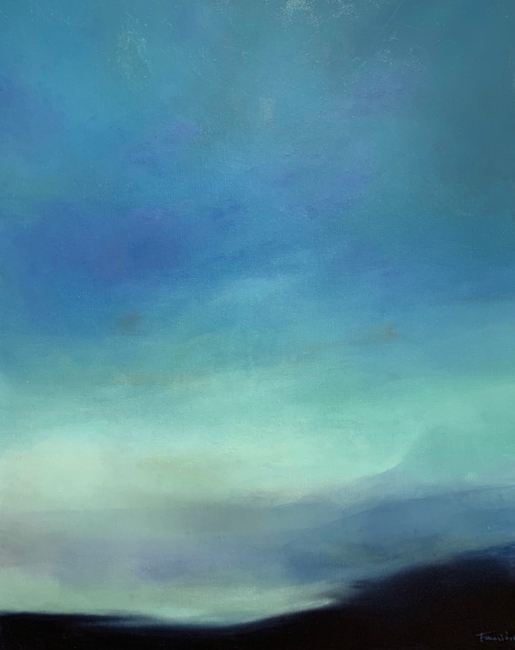
Ciò che manca completamente nelle opere della Frèniere è l’essere umano, come se nel suo mondo meditativo il rapporto di dialogo interiore dovesse svolgersi esclusivamente con la natura davanti a sé; sembra quasi che la Frèniere posizioni l’osservatore dietro una finestra dalla quale lasciarsi andare alla suggestione dei panorami che di volta in volta descrive. Contrariamente all’irruenza romantica, nei suoi paesaggi ciò che trapela è una sensazione di calma, le nubi costantemente presenti nelle tele, costituiscono un elemento rassicurante, di morbidezza espressiva dentro cui le sensazioni possono liberarsi e lasciarsi cullare dal loro lento ma costante movimento.
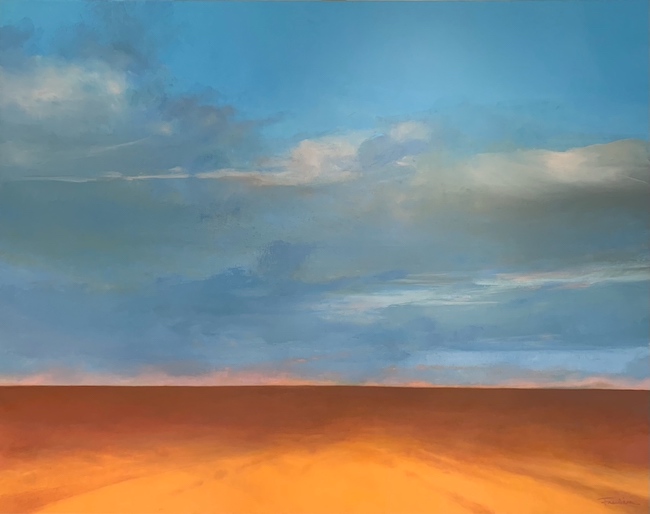
La luce è elemento dominante, protagonista assoluta proprio in virtù della sua capacità di essere guida, di trasportare lo sguardo verso l’orizzonte, confondendolo con l’ombra ma sempre lasciando una via d’uscita dal buio grazie alla sua presenza; emerge dunque un approccio equilibrato dell’artista nei confronti dell’esistenza, oltre alla serena consapevolezza che gli eventi abbiano sempre un risvolto positivo, una possibilità invisibile a un primo sguardo.
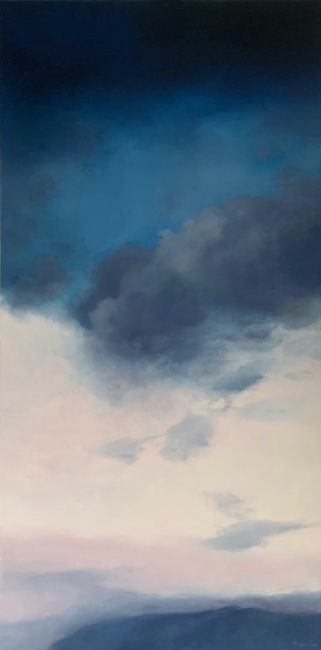
Ecco perché i paesaggi sembrano appartenere a un luogo non luogo, potrebbero essere uno o molti altri, lasciando nell’indefinitezza della descrizione una porta aperta all’interpretazione dell’anima dell’osservante; la guida di Nathalie Frèniere appare solo nel titolo, dopodiché ogni possibilità, ogni pensiero, ogni emozione, resta aperta, come se la sua arte fosse solo un mezzo per indurre il fruitore alla consapevolezza dell’importanza di lasciarsi andare a quelle sensazioni spesso trattenute e che solo davanti alla purezza della natura incontaminata possono emergere liberamente.
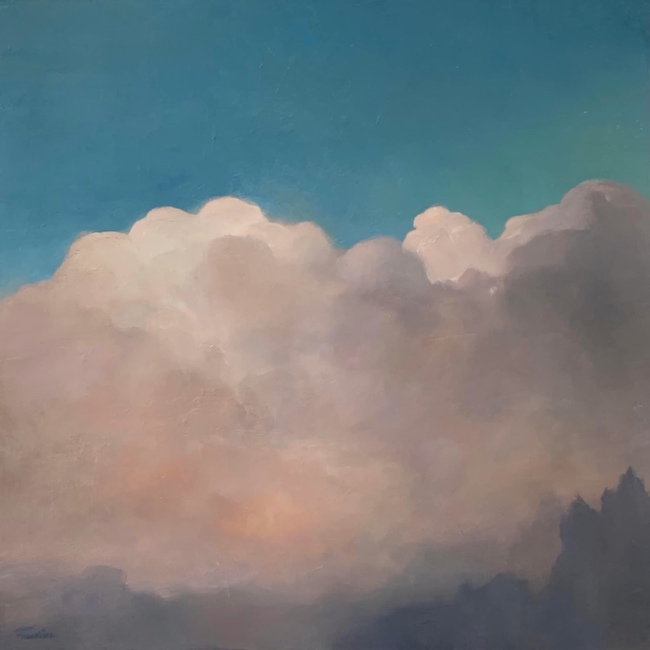
Nella tela Lucens (Splendente) viene immortalato esattamente quel passaggio tra nubi e sole, tra ombra e luce, che è metafora del senso della vita, quel dover a volte attraversare il grigio per emergere solo in un secondo tempo a ritrovare il sereno; ciò che sembra voler sottolineare l’artista è esattamente il contrasto tra l’azzurro della schiarita e il bianco delle nuvole, come se intendesse che è proprio in virtù di quell’essere rimasti per un po’ senza poter godere della bellezza del cielo che se ne può apprezzare meglio la tonalità turchese e intensa. Dunque lo splendore è quello stesso dell’alternanza, di quel costante scorrere delle circostanze che aprono la coscienza a nuova consapevolezza di sé.
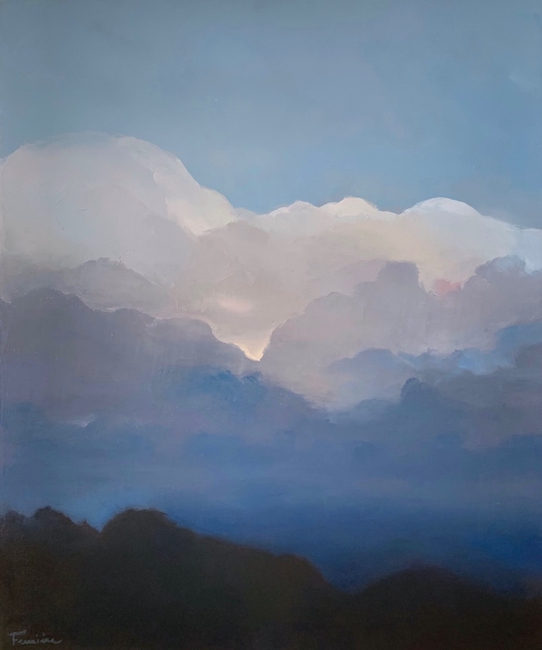
In Dawn of a New Day (Alba di un Nuovo Giorno) diviene evidente il forte legame con la pittura di Cozens, quella spinta mistica a lasciarsi trasportare dalla bellezza della semplicità, dalla meraviglia che si può provare davanti alla rigenerazione, alla rinascita quotidiana che scaturisce dal susseguirsi del giorno e la notte e che, ancora una volta infonde nell’osservatore l’esigenza di riflettere su quanto tutto ciò che appartiene al ciclo perpetuo della natura possa divenire esempio e spunto per un approccio alla vita differente, meno chiuso all’interno delle difficoltà che si possono incontrare e più aperto invece nei confronti delle infinite possibilità. Malgrado l’oscurità non sia ancora stata dissolta dal sole infatti, la leggerezza dell’aria sembra accordarsi alla speranza, alla musicalità di uno sguardo leggero in attesa di tutto ciò che di bello può verificarsi.
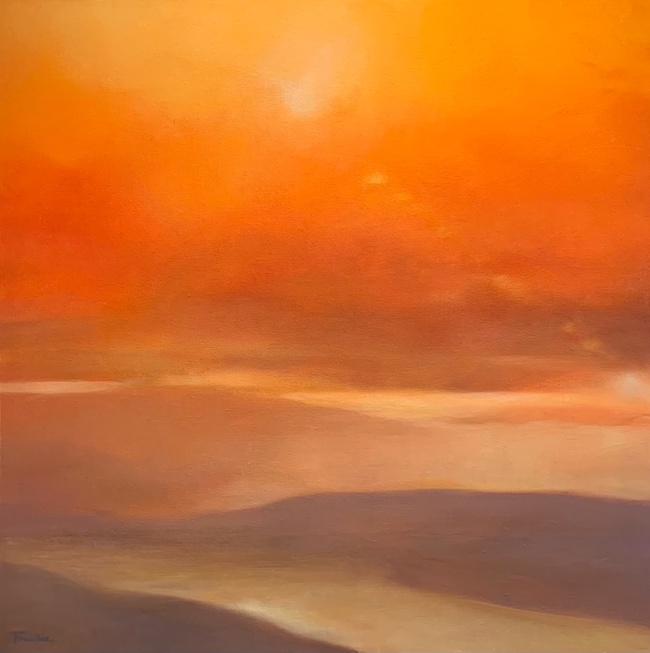
E ancora nella tela Let the Sunshine in (Lascia che il sole entri) non si può ignorare l’invito di Nathalie Frèniere a dischiudere l’interiorità alla luminosità del sole, capace di infondere calore e positività anche nei momenti di buio e dunque la risorsa maggiore per l’essere umano, così come la certezza, è ricordarne la luce anche quando non c’è e sapere che prima poi essa tornerà a far parte del prossimo giorno; le tonalità sono aranciate mentre i confini sono sfumati, si perdono quasi nell’astrazione accompagnando di fatto il fruitore dell’opera all’interno di un viaggio dell’anima da cui non riesce a sottrarsi, attratto dal suo magico magnetismo.
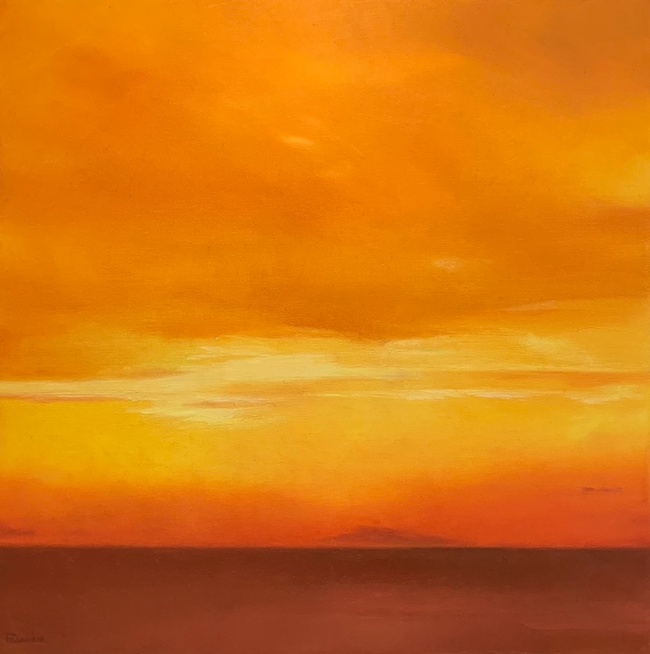
Artista da sempre Nathalie Frèniere si è laureata in Arte al College Salette di Montréal, ha studiato in diversi atelier di maestri a Parigi e dal 2006 ha realizzato numerose mostre collettive e personali in Canada, Stati Uniti e Brasile, ricevendo importanti premi tra cui Donna dell’anno 2014 nella categoria Arte in Ontario; ha esposto al Musée des Beaux-Arts du Mont-Saint-Hilaire accanto ai più grandi nomi dell’arte canadese e in Brasile per il Bola Show, in occasione del progetto espositivo FIFA a Rio de Janeiro per il quale ha rappresentato l’Ontario. Le sue opere sono rappresentate da gallerie di New York, Quebec, Toronto e Ottawa. È stata membro della giuria dell’Ontario Arts Council (OAC). Sono stati pubblicati diversi articoli sulla sua arte, tra cui uno pubblicato sull’importante rivista Magazin’art.
NATHALIE FRÈNIERE-CONTATTI
Email: nathalie-freniere@hotmail.com
Sito web: https://www.nathaliefreniere.com/
Facebook: https://www.facebook.com/nathalie.freniere.5
Instagram: https://www.instagram.com/nathaliefreniereartiste/
Nahalie Frèniere, the romantic gaze on pristine landscapes listening to the vibrations of the soul
Contemporary art often stands as an overcoming of everything that belongs to a more traditional era or approach, continuing that detachment generated in the 20th century that still leads many creatives today to seek a distinctive, unique language to mark their own expressive path and to give their work a personal footprint; however, there is also a large group of artists who, on the contrary, seek out, reconnect with and are inspired by precisely that apparently distant yet incredibly effective past in allowing them to let their own emotions emerge without feeling challenged their contemporaneity, their modernity in combining style with the ability to connect with their own inner world and, consequently, interpret the observed. The artist I am going to present to you today binds herself to a fascinating and captivating artistic strand, tying herself strongly to a style of the past but incredibly personalised.
The pictorial tendency to immortalise scenes in the open air, highlighting nature or the contact between nature and human beings, was considered a minor art until the 17th century, as the main commissions came to the great painters from the Church or from royal families and nobility, so the subjects were almost exclusively religious and historical. It was, however, between the end of the 18th century and the beginning of the 19th century that this genre had its greatest representatives, because already towards the end of the 18th century English Romanticism transformed the ability to depict seascapes or country views into expressions of the artist’s interiority, of that narration of what was defined as the sublime, understood as fear and a sense of powerlessness in the face of the force and impetuosity of nature; two of the greatest exponents of this pictorial current, destined to leave a profound mark on the history of art and to be a prelude to later research, were William Turner and John Robert Cozens, who made the theme of the sublime their major expression. Turner’s stormy and impetuous panoramas and Cozens’ hazy and evocative atmospheres have the expressive power to involve the observer and at the same time convey to him the interpretation of the sensations that the author of the canvases felt the need to manifest, leaving him to reflect on the indomitable majesty of nature. What was striking in Turner’s artworks was his relationship with light, that luminosity capable of infusing the atmospheres with an impalpable, rarefied aspect, almost in contrast to the events described. It was precisely his artistic production that laid the foundations for Impressionism, which made landscape painting a distinctive characteristic, also due to the peculiarity of painting en plein air, meticulously describing the perfection of the colours using the effect of light and omitting drawing precisely to instil the sensation of immediacy and to satisfy the need for speed of execution possible thanks to the new painting technique consisting of small, brief touches of colour juxtaposed and mixed together to compose the final artwork.
Claude Monet’s canvas Impression, soleil levant is considered to be the work that officially decreed the birth of Impressionism and which, while pursuing aesthetic perfection, infuses the observer with a contemplative impulse, deeper than the purely aesthetic one that constituted the expressive tendency of the current. The Canadian artist Nathalie Frèniere draws her inspiration from Impressionism, however, one cannot fail to notice the proximity to the atmospheres of William Turner’s English Romanticism, although in her artwork emerges the contemplative aspect rather than the awe provoked by nature that permeates the works of the English master, the aspect that leads to introspection through the gaze involved in the landscapes described. What is completely missing in Frèniere’s paintings is the human being, as if in her meditative world the inner dialogue should take place exclusively with nature in front of her; it almost seems as if Frèniere places the observer behind a window from which to let himself go to the suggestion of the panoramas she describes from time to time. Contrary to the romantic impetuosity, what transpires in her landscapes is a feeling of calm, the clouds constantly present in the canvases, constituting a reassuring element of expressive softness within which sensations can be freed and let themselves be lulled by their slow but constant movement. Light is the dominant element, the absolute protagonist precisely by virtue of its ability to be a guide, to transport the gaze towards the horizon, confusing it with shadow but always leaving a way out of the darkness thanks to its presence; what emerges, then, is the artist’s balanced approach to existence, as well as the serene awareness that events always have a positive side, a possibility invisible at first glance.
This is why the landscapes seem to belong to a place non-place, they could be one or many others, leaving in the indefiniteness of the description an open door to the interpretation of the soul of the observer; Nathalie Frèniere’s guide appears only in the title, after which every possibility, every thought, every emotion, remains open, as if her art were only a means to induce the viewer to the awareness of the importance of letting go of those feelings often held back and that only in front of the purity of uncontaminated nature can they emerge freely. In the canvas Lucens (Shining), we see exactly that passage between clouds and sun, between shadow and light, which is a metaphor for the meaning of life, that having sometimes to go through the grey to emerge only later to find serenity again; what the artist seems to want to emphasise is precisely the contrast between the blue of the clearing and the white of the clouds, as if she meant that it is precisely by virtue of having remained for a while without being able to enjoy the beauty of the sky that is possible to better appreciate its intense turquoise hue. So the splendour is that of alternation, of that constant flow of circumstances that opens the consciousness to new self-awareness. In Dawn of a New Day, the strong link with Cozens’ painting becomes evident, that mystical urge to let oneself be transported by the beauty of simplicity, by the wonder that can be felt in the face of regeneration, of the daily rebirth that springs from the succession of day and night, and that once again instils in the observer the need to reflect on how everything that belongs to the perpetual cycle of nature can become an example and a cue for a different approach to life, less closed within the difficulties that one may encounter and more open instead to the infinite possibilities. Despite the fact that the darkness has not yet been dissolved by the sun, the lightness of the air seems to be in tune with hope, with the musicality of a light gaze in expectation of all that is beautiful that can occur. And again in the canvas Let the Sunshine in, one cannot ignore Nathalie Frèniere’s invitation to open one’s interiority to the brightness of the sun, capable of instilling warmth and positivity even in moments of darkness, and therefore the greatest resource for the human being, as well as the certainty, is to remember the light even when it is not there and to know that sooner or later it will return to be part of the next day; the tones are orangey while the borders are blurred, they are almost lost in abstraction, accompanying the viewer of the painting on a journey of the soul from which he cannot escape, attracted by its magical magnetism.
A lifelong artist, Nathalie Frèniere graduated in Art at the College Salette in Montréal, studied at various ateliers of masters in Paris and since 2006 has had many group and solo exhibitions in Canada, the United States and Brazil, receiving important prizes including Woman of the Year 2014 in the Art category in Ontario; she has exhibited at the Musée des Beaux-Arts du Mont-Saint-Hilaire alongside the biggest names in Canadian art and in Brazil for the Bola Show, at the FIFA exhibition project at Rio de Janeiro for which she represented Ontario. Her artworks are represented by galleries in New York, Quebec, Toronto and Ottawa. She has been a jury member for the Ontario Arts Council (OAC). Several articles have been published on her arts, among others, an article about her artwork appeared in the important journal Magazin’art.


